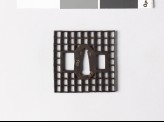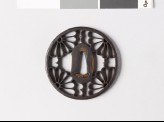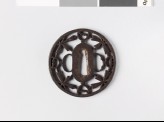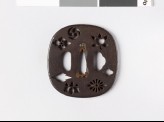The A. H. Church Collection of Japanese Sword-Guards (Tsuba)
An unpublished catalogue of the A. H. Church collection of Japanese sword-guards (tsuba) by Albert James Koop.
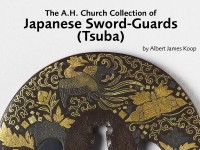
According to some authorities, the tsuba-shi or tsuba-kō (“guard artist”), by which is meant a craftsman devoting himself solely to the making of tauba, first arose about 1400 A.D., when the Shōgun Ashikaga Yoshinori (1394-1441) established private guard-makers at his court in Heianjō (Kiōto) and caused his artists to design guards with piercings (sukashi) of a more refined and decorative character than those of the earlier swordemiths and armourers.
These Heianjō-sukashi guards are usually circular, with rounded edges, and the designs are in positive silhouette filling nearly the whole of the field.
Owari-sukashi guards are similar, but thicker and less refined in appearance. Owari and its capital Nagoya dominated the central provinces, and Heianjō workers and others from the west seem to have settled there at an early date.
A well-defined early type goes by the name of Kamakura-tsuba, though quite unconnected with the medieval Shōogunal capital, Kamakura, or its period (1192-1333). These tsuba are thin and of rough appearance, with designs in very flanged relief accompanied by slightly flanged negative piercings.
None of the foregoing guards is ever signed, and no makers’ names are known.
Tembō-tsuba are named after a 16th-century artist working at Sanoda in Yamashiro and signing Ten-hō [Japanese text] of Yamashiro. Thick and rough-looking guards, they are peculiar in having die-etampings, generally of Chinese characters such as [Japanese text] and others, applied while the iron is cold.
Early Owari work also includes guards signed Yamakichi, Yamakichibei, or, in full, Yamazaka Kichibei [Japanese text] thick and of very irregular surface, with a few indefinite piercings.
A succession of artists bearing the family name of Hōan [Japanese text] worked otiginally in Owari under the Asano daimios, following in the latter’s train when they were transferred to the successive fiefs of Kōshū (1598), Kishū (1600), and finally Hiroshima in Aid (1619). They produce gurds of well-forged iron with flat reliefs or die-stampin often of Chinese coins.
Guards signed Sadahiro are fine pieces of forging, somewhat in armourers’ style.
It should be noted that work more or less in the style above described was continued, often by independent (and anonymous) imitators, as late as the 18th and even the first half of the 19th century.
“Kamakura” style
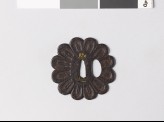 Tsuba in the form of a chrysanthemum (EAX.10005)
Tsuba in the form of a chrysanthemum (EAX.10005)
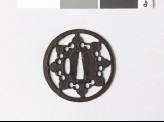 Tsuba with eight-petalled flower (EAX.10006)
Tsuba with eight-petalled flower (EAX.10006)
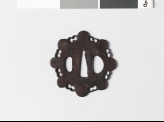 Tsuba in the form of a stylized flower (EAX.10007)
Tsuba in the form of a stylized flower (EAX.10007)
Heianjō-sukashi
 Tsuba with floral device of overlapping petals (EAX.10008)
Tsuba with floral device of overlapping petals (EAX.10008)
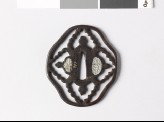 Tsuba with karahana, or Chinese flowers (EAX.10009)
Tsuba with karahana, or Chinese flowers (EAX.10009)
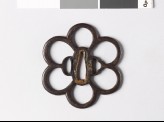 Tsuba in the form of a flower (EAX.10010)
Tsuba in the form of a flower (EAX.10010)
 Mokkō-shaped tsuba with scrolls (EAX.10011)
Mokkō-shaped tsuba with scrolls (EAX.10011)
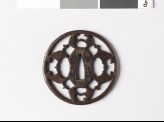 Round tsuba with myōga, or ginger shoots, and karigane, or flying geese (EAX.10012)
Round tsuba with myōga, or ginger shoots, and karigane, or flying geese (EAX.10012)
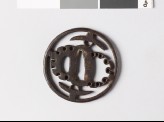 Round tsuba with hats and stylized snow heaps (EAX.10013)
Round tsuba with hats and stylized snow heaps (EAX.10013)
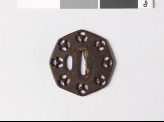 Octagonal tsuba with three-petalled flowers (EAX.10014)
Octagonal tsuba with three-petalled flowers (EAX.10014)
 Tsuba with arrow-head shapes (EAX.10015)
Tsuba with arrow-head shapes (EAX.10015)
 Tsuba with petals and sword-blades (EAX.10016)
Tsuba with petals and sword-blades (EAX.10016)
Owari-sukashi
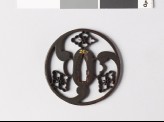 Round tsuba with karahana, or Chinese flowers (EAX.10019)
Round tsuba with karahana, or Chinese flowers (EAX.10019)
 Tsuba with heraldic crane (EAX.10020)
Tsuba with heraldic crane (EAX.10020)
 Tsuba with mon crest of the Hachisuka family (EAX.10021)
Tsuba with mon crest of the Hachisuka family (EAX.10021)
 Tsuba with mon crest of the Hori of Iida family (EAX.10022)
Tsuba with mon crest of the Hori of Iida family (EAX.10022)
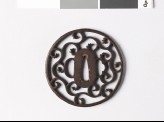 Round tsuba with karakusa, or scroll plant pattern (EAX.10023)
Round tsuba with karakusa, or scroll plant pattern (EAX.10023)
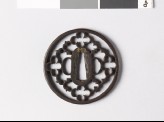 Round tsuba with karigane, or flying geese (EAX.10024)
Round tsuba with karigane, or flying geese (EAX.10024)
 Round tsuba with gosan-no-kiri, or paulownia leaves (EAX.10025)
Round tsuba with gosan-no-kiri, or paulownia leaves (EAX.10025)
 Round tsuba with hexagonal cobweb (EAX.10026)
Round tsuba with hexagonal cobweb (EAX.10026)
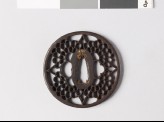 Round tsuba with four chrysanthemum flowers (EAX.10027)
Round tsuba with four chrysanthemum flowers (EAX.10027)
Daigorō guards
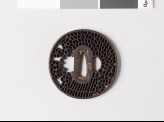 Round tsuba with a large faggot and plum blossoms (EAX.10029)
Round tsuba with a large faggot and plum blossoms (EAX.10029)
 Square tsuba with cloud-forms (EAX.10030)
Square tsuba with cloud-forms (EAX.10030)
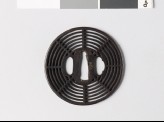 Round tsuba with cobweb design (EAX.10031)
Round tsuba with cobweb design (EAX.10031)
Early pierced iron guards, various
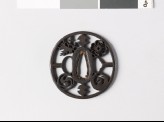 Tsuba with four mon and two fundō weights (EAX.10032)
Tsuba with four mon and two fundō weights (EAX.10032)
 Round tsuba with yatsu-hashi, or eight-bridges, design (EAX.10033)
Round tsuba with yatsu-hashi, or eight-bridges, design (EAX.10033)
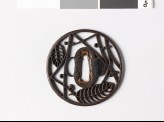 Round tsuba with oak leaves and pine needles (EAX.10034)
Round tsuba with oak leaves and pine needles (EAX.10034)
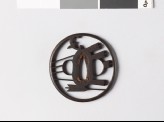 Tsuba with arrows and myōga, or ginger shoots (EAX.10035)
Tsuba with arrows and myōga, or ginger shoots (EAX.10035)
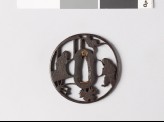 Round tsuba depicting Sōsan, a Paragon of Filial Virtue, and his mother (EAX.10036)
Round tsuba depicting Sōsan, a Paragon of Filial Virtue, and his mother (EAX.10036)
 Tsuba with two horses and bamboo twigs (EAX.10037)
Tsuba with two horses and bamboo twigs (EAX.10037)
A series of chrysantehmoid guards
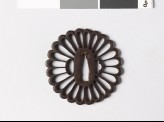 Tsuba in the form of a chrysanthemum (EAX.10039)
Tsuba in the form of a chrysanthemum (EAX.10039)
 Tsuba in the form of a chrysanthemum (EAX.10040)
Tsuba in the form of a chrysanthemum (EAX.10040)
 Round tsuba with radiating floral design (EAX.10041)
Round tsuba with radiating floral design (EAX.10041)
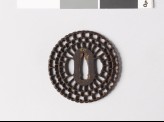 Round tsuba with radiating floral design (EAX.10042)
Round tsuba with radiating floral design (EAX.10042)
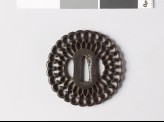 Tsuba in the form of a flower (EAX.10043)
Tsuba in the form of a flower (EAX.10043)
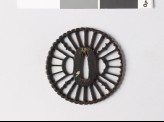 Tsuba with chrysanthemum florets and karigane, or flying geese (EAX.10044)
Tsuba with chrysanthemum florets and karigane, or flying geese (EAX.10044)
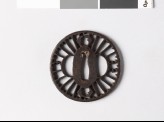 Round tsuba with myōga, or ginger shoots, and flying geese, or karigane (EAX.10045)
Round tsuba with myōga, or ginger shoots, and flying geese, or karigane (EAX.10045)
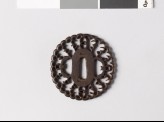 Tsuba in the form of a flower with myōga, or ginger shoots, and karigane, or flying geese (EAX.10046)
Tsuba in the form of a flower with myōga, or ginger shoots, and karigane, or flying geese (EAX.10046)
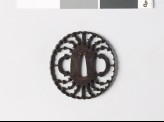 Tsuba in the form of a flower with myōga, or ginger shoots, and karigane, or flying geese (EAX.10047)
Tsuba in the form of a flower with myōga, or ginger shoots, and karigane, or flying geese (EAX.10047)
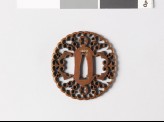 Tsuba with myōga, or ginger shoots and karigane, or flying geese (EAX.10048)
Tsuba with myōga, or ginger shoots and karigane, or flying geese (EAX.10048)
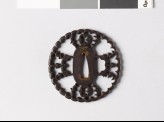 Round tsuba with myōga, or ginger shoots, and karigane, or flying geese (EAX.10049)
Round tsuba with myōga, or ginger shoots, and karigane, or flying geese (EAX.10049)
 Tsuba with myōga, or ginger shoots, and four karigane, or flying geese (EAX.10050)
Tsuba with myōga, or ginger shoots, and four karigane, or flying geese (EAX.10050)
 Round tsuba with fundō weights and circles (EAX.10051)
Round tsuba with fundō weights and circles (EAX.10051)
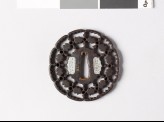 Tsuba with fundō weights and circles (EAX.10052)
Tsuba with fundō weights and circles (EAX.10052)
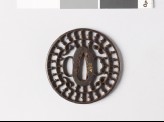 Tsuba with karigane, or flying geese, and c-scrolls (EAX.10053)
Tsuba with karigane, or flying geese, and c-scrolls (EAX.10053)
Miscellaneous designs
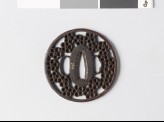 Round tsuba with plum and cherry blossoms (EAX.10055)
Round tsuba with plum and cherry blossoms (EAX.10055)
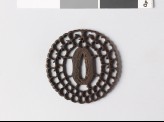 Tsuba with sagari-fuji mon and karigane, or flying geese (EAX.10056)
Tsuba with sagari-fuji mon and karigane, or flying geese (EAX.10056)
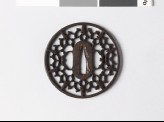 Round tsuba with myōga, or ginger shoots, and kiri, or paulownia leaves (EAX.10057)
Round tsuba with myōga, or ginger shoots, and kiri, or paulownia leaves (EAX.10057)
Yamkichi
Tembō
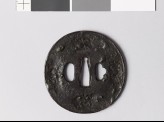 Tsuba with star forms (EAX.10061)
Tsuba with star forms (EAX.10061)
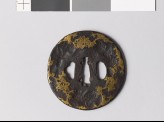 Tsuba with stylized snow decoration (EAX.10062)
Tsuba with stylized snow decoration (EAX.10062)
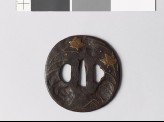 Tsuba with grasses and butterflies (EAX.10063)
Tsuba with grasses and butterflies (EAX.10063)
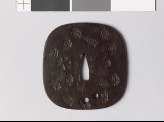 Tsuba with stars and signatures (EAX.10064)
Tsuba with stars and signatures (EAX.10064)
Sadakane and other Kishū workers
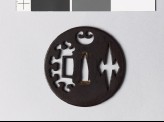 Round tsuba with a snow heap and matsukawa-bishi, or overlapping lozenges (EAX.10065)
Round tsuba with a snow heap and matsukawa-bishi, or overlapping lozenges (EAX.10065)
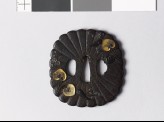 Tsuba with chrysanthemum florets and aoi, or hollyhock leaves (EAX.10066)
Tsuba with chrysanthemum florets and aoi, or hollyhock leaves (EAX.10066)
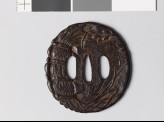 Tsuba with plants and a Buddhist invocation (EAX.10067)
Tsuba with plants and a Buddhist invocation (EAX.10067)
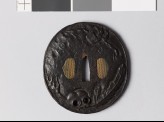 Tsuba with skull and New Year decorations (EAX.10068)
Tsuba with skull and New Year decorations (EAX.10068)
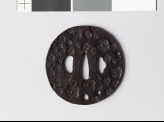 Tsuba with cherry blossoms (EAX.10069)
Tsuba with cherry blossoms (EAX.10069)
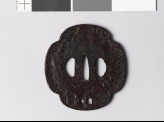 Mokkō-shaped tsuba with inscription in cursive script (EAX.10070)
Mokkō-shaped tsuba with inscription in cursive script (EAX.10070)
Hōan
Notice
Object information may not accurately reflect the actual contents of the original publication, since our online objects contain current information held in our collections database. Click on 'buy this publication' to purchase printed versions of our online publications, where available, or contact the Jameel Study Centre to arrange access to books on our collections that are now out of print.
© 2013 University of Oxford - Ashmolean Museum


